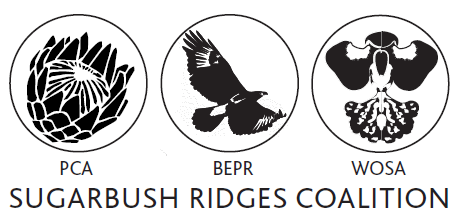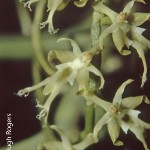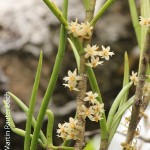Tridactyle
[Text placeholder delete after updating]Describe the characteristics of the Genus[Text placeholder delete after updating]
Credit
[Text placeholder delete after updating]Short credit and reference for the Genus introduction[Text placeholder delete after updating]
Tridactyle bicaudata subsp. bicaudata.
Description
Slender to robust epiphyte or lithophyte, stems stout, usually erect, up to 350mm long and 4-6mm in diameter, roots separated from leaves by a length of bare stem. Leaves in 2 opposite rows, leathery, linear to strap-shaped, rounded, unequally bilobed. Inflorescences dense, appearing from the axils of the leaves, 30-80mm long, 6-20 flowers, upward facing, palish yellow to brown. Also see subs. rupestris.
Tridactyle bicaudata subsp. rupestris
Description
Please see the article on Tridactyle bicaudata subsp. bicaudata. This differs from the other form, which is lithophytic, leaves stiff, curved and up to 60mm long.
Tridactyle gentilii
Description
Slender epiphyte, reed like stems up to 400mm long and 7mm in diameter. Leaves linear to strap-shaped, unequally bilobed and up to 150mm long. Inflorescences fairly dense, borne below the leaves, up to 70mm long. Up to 8 flowers, upward facing, white, up to 20mm in diameter, spur long up to 80mm.
Tridactyle tricuspis
Description
Slender to robust epiphyte, Stems erect and up to 200mm long, but usually much shorter, 6mm in diameter. Roots produced along the length of the stem to a base of leaves. Leaves closely overlapping in 2 rows, linear or strap-shaped, unequally bilobed. Inflorescences fairly dense, borne below the leaves and up to 120mm long. 10-25 flowers greenish to cream, up to 11mm long. Clump forming.
Tridactyle tridentata
Description
Slender epiphyte or lithophyte, stems up to 300mm long, branching, angled and 3mm in diameter. Roots restricted to the very base. Leaves arranged in 2 rows, circular in cross-section, grooved, stiff and often fleshy. Inflorescences borne below the leaves, shorter than 5mm, 2-5 flowers which are pale green to cream, which are up to 8mm in diameter, sepals spreading , petals strap shaped, lip side lobes tooth like, spur 7-8mm long.
For more information regarding the preservation of South Africa's wild Orchids or if you would like to get involved please email This email address is being protected from spambots. You need JavaScript enabled to view it. or complete this short form Contact Us and we will contact you.



